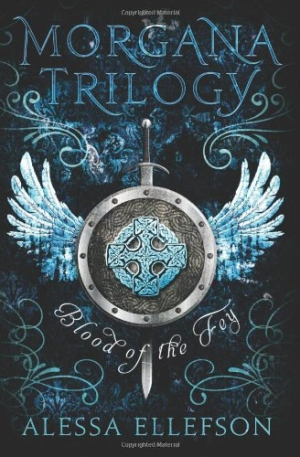Blood of the Fey
Morgana Trilogy Book 1
Ellefson delights in her creations and possesses the raw talent to breathe new life into old legends.
Debut author Alessa Ellefson successfully modernizes the King Arthur legend for teens with Blood of the Fey, the first novel in her Morgana Trilogy. Ellefson adroitly weaves together legend and high school for a refreshing look at timeless dualities: magic versus religion, good versus evil, and self-identity versus group membership.
Seventeen-year-old Morgan Pendragon has never known the love of family or friends. While her alienation is extreme, she constantly echoes sentiments sure to resonate with the adolescent audience: “Life is just not fair…I’ve tried everything I can think of to conform and be accepted, but nothing’s worked.” Circumstances change, however, when Morgan’s distant parents pluck her from her Swiss Catholic boarding school and send her off to a new school in Wisconsin with her arrogant half-brother, Arthur. As head of the Knights of the Round Table (KORT), Arthur commands an elite group of students whose decrees govern everything.
A devout Catholic, the use of magic shocks Morgan. She soon learns that she and her fellow students must train as knights, wielding swords and magic to protect the planet from the Fey, powerful magical fallen angels who seek to subjugate humanity. She makes waves as she questions her classmates’ wholesale denunciation of the Fey. She challenges Arthur: “You can’t condemn a whole race, or people…because some individuals are rotten. Would you want to destroy all of humanity because a few happen to be scumbags?…I don’t think so.”
The protagonist comes across as a whip-smart misfit who bears constant disappointment with a healthy dose of sarcasm, which often manifests itself in evocative similes. Her teacher’s long mustache “hang[s] severely low, like the tusks of a walrus.” However intelligent and snarky Morgan is, one wishes Ellefson would stop using her as a punching bag. Morgan doesn’t initiate things; things happen to her, from minor mishaps to cataclysmic catastrophes.
Even when Morgan finds herself doing something heroic, her supposed friends respond negatively. She falls into and out of the good graces of Arthur and her purported pals with dizzying speed. Readers can empathize with the poor girl only for so long before becoming exhausted. Such internal inconsistency afflicts Arthur and the secondary characters, as well. That the major characters suffer the whims of the plot is odd because the wonderful tertiary characters are fully realized: Morgan’s aloof, vaguely menacing parents; Puck, an endearing hobgoblin; and various brawny avuncular boy knights.
The book’s pacing also stumbles, with foreshadowing ranging from excessive to too little. The author does well at laying the groundwork for the overarching conflict, but the encounters with villainous Fey are often over too quickly to build up to the all-out war the book promises. Further, the author crams every Arthurian element she can into this installment but gives some short shrift. The inclusion of Excalibur and the Holy Grail, for example, feels like an afterthought. Since she has two more books planned in the trilogy, there is no need to overfill this one.
Clearly imaginative Ellefson delights in her creations and possesses the raw talent to breathe new life into old legends.
Reviewed by
Jill Allen
Disclosure: This article is not an endorsement, but a review. The publisher of this book provided free copies of the book and paid a small fee to have their book reviewed by a professional reviewer. Foreword Reviews and Clarion Reviews make no guarantee that the publisher will receive a positive review. Foreword Magazine, Inc. is disclosing this in accordance with the Federal Trade Commission’s 16 CFR, Part 255.

